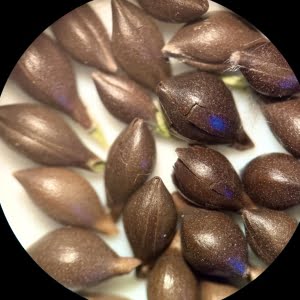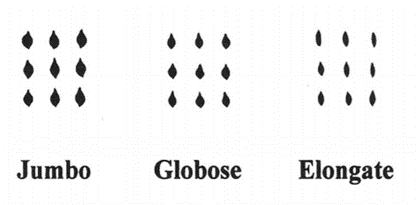
Science Corner: Seed Dormancy and the Dizzying Variability of Ricegrass
March 2021
In the Southwest, variability is a defining fact of ecological processes. This is especially true of precipitation where “averages” (as in the average rainfall in Santa Fe, NM is 14 inches per year) are so rarely met, they serve as more of an academic statistic than an on-the-ground reality. Variability is also inherent in the physical landscape. Maps of soil types, for example, show a complex mosaic over short distances as a result of mountain forming, erosion, volcanic eruptions and myriad other gradual and sudden geologic events. Moreover, humans have influenced variability in the southwestern landscape over at least 11,000 years of reciprocal interaction with plants, animals, rivers, and nearly every feature we think of as part of the “natural world”. Through all of these influences and their ingrained variability, plants in the region have developed specialized strategies to survive. Here, we dive into the natural history of a native perennial grass, Indian ricegrass (Achnatherum hymenoides; hereafter referred to as ricegrass), and how this beloved species has evolved to weather variability, particularly through an adaptive strategy called seed dormancy. We also explore how ricegrass seed dormancy comes into play in restoring degraded land in an environment that will only become more variable under a changing climate.
Ricegrass is a drought-tolerant perennial bunchgrass widely distributed across western North America. It is recognizable by its wiry blades and spreading inflorescence with single florets at the tip of fine panicle branches. It is highly palatable for livestock and wildlife, and the seeds are nutritious for birds and rodents. In New Mexico, we often find it in sandy sites on the margins of arroyos (dry, sandy water courses that can flood during extreme rainfall events). Since it is a cool-season grass, it greens up and produces seed in spring to early summer, providing forage when many plants in the region that respond to late-summer monsoonal precipitation are still dormant. Ricegrass also has a long history of use as food by native people throughout its distribution—its seeds were ground into meal for bread or porridge. These characteristics of ricegrass make it a highly desirable restoration species and a primary candidate for seed production as part of our Southwest Seed Partnership efforts.
In addition to the ecological benefits ricegrass offers, it has a complicated evolutionary history and adaptations to survive variable conditions that make it challenging to grow for restoration. Specifically, ricegrass has three, genetically distinct seed morphs (more on that soon), that exhibit varying degrees of seed dormancy and occur in overlapping populations.
Seed dormancy can be defined as the presence of physiological (i.e. chemical and physical processes within seeds like respiration and metabolism) or morphological (i.e. physical characteristics like thick coatings around seed) barriers that prevent germination of viable seeds even under favorable conditions. Seed dormancy allows seeds to remain in the soil seed bank for long periods of time as a sort of insurance policy for the species –if all seeds from a species germinated at once and many didn’t survive to produce seed, that would spell the end of that species in a short time period. By remaining viable but dormant in the soil seed bank, germination can be staggered or delayed in response to cues that break dormancy such as cold and wet conditions (stratification) or wearing down of physical barriers that prevent seeds from taking in water (scarification).
Ricegrass seed possesses both physiological and morphological dormancy, so in order to germinate seeds in a greenhouse, restoration site, or seed production field, we must do various treatments to break dormancy. Treatments to break physiological dormancy typically involve some sort of cold stratification or placing seeds in a moist, cold environment to simulate over-wintering; this can be done in a refrigerator, or by fall planting to allow seeds to experience natural winter soil conditions. To break morphological dormancy in ricegrass, some sort of mechanical or chemical treatment must be applied to physically break down the hard bracts that surround the seed, called the lemma and palea, and allow the seed to take in oxygen and water which trigger germination.
Another factor that further complicates how we think about ricegrass dormancy is that there are three separate “seed morphs” with distinct shapes—categorized as jumbo, globose, and elongate—and different degrees of dormancy related to the thickness of the lemma and palea. The jumbo seed morph has the highest degree of dormancy due to its thicker lemma and palea and resulting larger seed mass (hence “jumbo”). These seed morphs occur separately on individual plants and are genetically distinct, meaning they do not interbreed with one another. The unique genetic lineages of the different morphs are maintained, even when individuals with different seed morphs occur at the same site, because ricegrass is mainly self-pollinating so individuals do not typically interbreed with neighboring plants. This means that when we are collecting seed from a wild population, we are potentially getting more than one seed morph and seeds that represent distinct genetic lineages.
All of this complicated variability related to seed dormancy can be advantageous in the variable landscapes of western North America—seeds with different degrees of dormancy will be able to thrive under different environmental conditions and the relative amounts of different seed morphs may change over time in response to changing conditions.
Dormancy-breaking increases time and financial inputs of producing seeds for restoration. For this reason, dormancy has sometimes been treated as something to “breed out” with the goal of producing seed that germinates more readily. While dormancy presents challenges for producing ricegrass, our program’s goals include producing seed that is diverse and adapted to weather existing variability, as well as the predicted challenges associated with climate change. As we move forward with growing ricegrass and other species, we aim to apply research and techniques to ensure we can capture a range of variability present in wild populations. Our ricegrass seeds that are currently chilling under moist stratification conditions will soon be planted in a one-acre production field at Bamert Seed Company. Eventually, this seed will be available for use in restoration in our region where it can be applied to boost biodiversity and resiliency in an ever-changing environment.
We would like to thank the New Mexico Bureau of Land Management for funding this project, and Tom Jones of the USDA Agricultural Research Service (Utah) for providing expert guidance on ricegrass morphs and dormancy breaking.
References
Jones, T.A. and D.C. Nielson. (1996). Seed size and shape and lemma color polymorphism in Oryzopsis hymenoides (Roem. & Schult.) Ricker. P. 272-273. In: N.E. West (ed.), Proc. Vth Int. Rangeland Congress, Salt Lake City, Utah. 23-28 July 1995.
Jones, T. A., and D. C. Nielson. (1999). Intrapopulation genetic variation for seed dormancy in India ricegrass. Rangeland Ecology & Management/Journal of Range Management Archives 52.6 (1999): 646-650.
Jones, T. A., Redinbaugh, M. G., Larson, S. R., Zhang, Y., & Dow, B. D. (2007). Polymorphic Indian ricegrass populations result from overlapping waves of migration. Western North American Naturalist, 67(3), 338-346.
Restoration
Research
Education
Get Involved
Contact
Main Office:
4950 SW Hout Street
Corvallis, OR 97333-9598
541-753-3099
info@appliedeco.org
Southwest Office:
1202 Parkway Dr. Suite B
Santa Fe, NM 87507
(505) 490-4910
swprogram@appliedeco.org
© 2025 Institute for Applied Ecology | Privacy Policy




